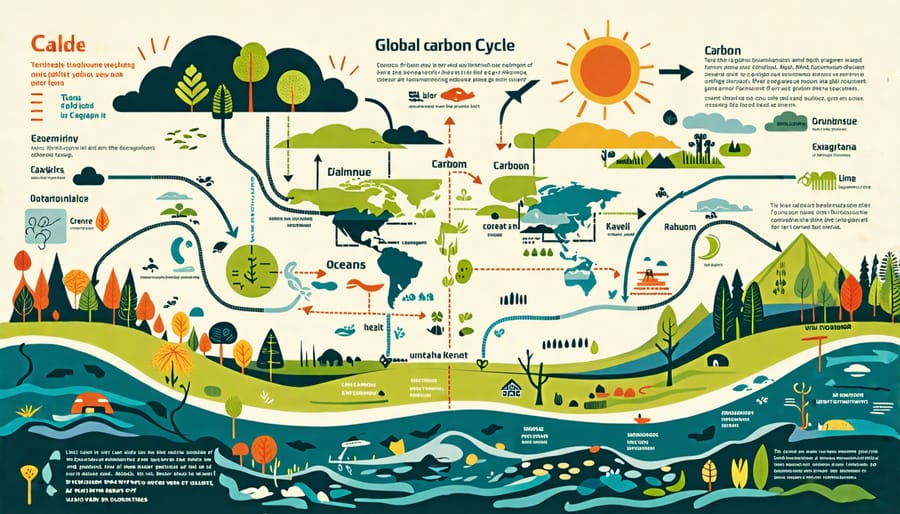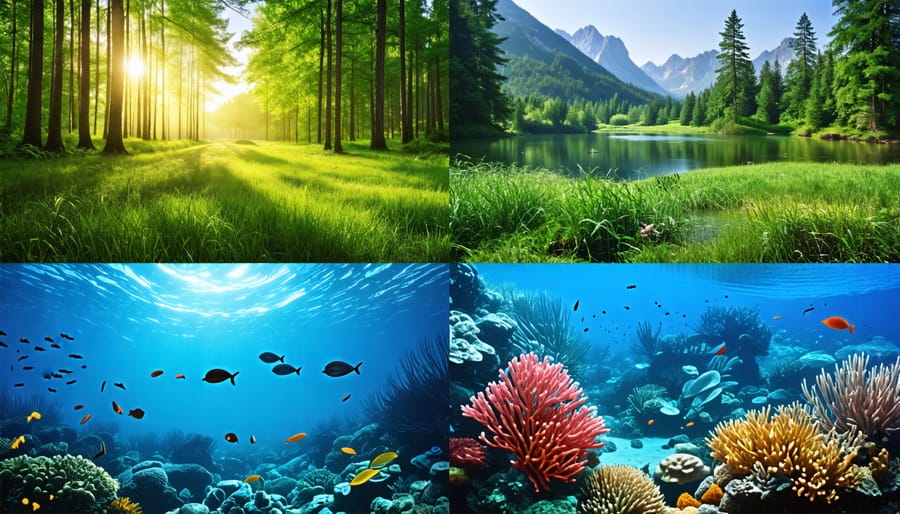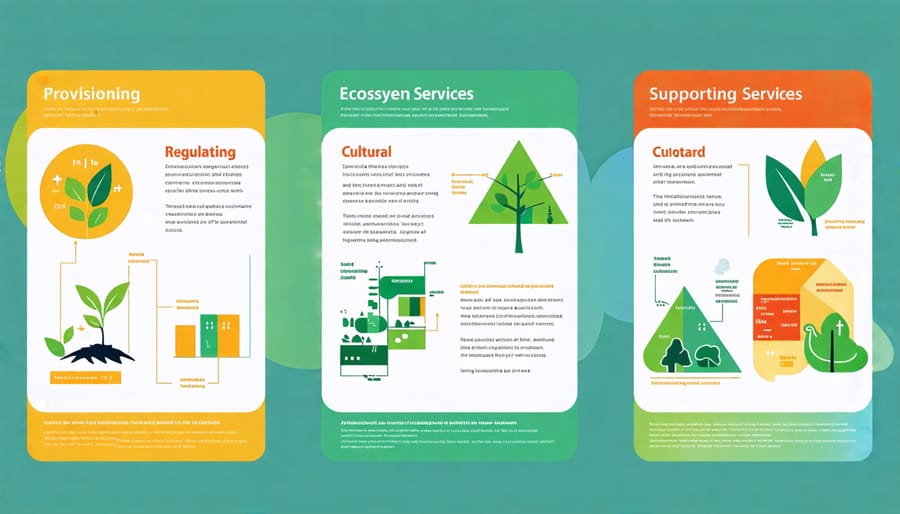Here is a 200-word introduction for an article on carbon sequestration as an ecosystem service:
Carbon sequestration, the long-term capture and storage of atmospheric carbon dioxide, provides a vital ecosystem service that benefits the entire planet. Through the remarkable ability of plants to convert CO2 into biomass via photosynthesis, healthy ecosystems like forests, grasslands, wetlands and oceans act as massive carbon sinks, pulling billions of tons of carbon out of the atmosphere each year.
This natural process, refined over eons, is now one of our most powerful tools in the fight against climate change. By absorbing a significant portion of humanity’s carbon emissions, these ecosystems mitigate warming and help regulate the Earth’s climate. They also provide myriad other benefits like clean air and water, biodiversity, and resources that drive economies worldwide.
Yet as deforestation, development, and other human activities degrade ecosystems, their capacity for carbon sequestration is diminished. Protecting and restoring carbon-rich habitats is therefore critical, not only for their low-carbon energy potential but for the web of life they sustain. Recognizing carbon sequestration as an ecosystem service can drive policies and market solutions that properly value nature’s role in stabilizing our climate. The race to slash emissions may hinge on preserving the power of photosynthesis on a global scale.
Understanding Carbon Sequestration
The Global Carbon Cycle
The global carbon cycle involves the continuous exchange of carbon between the atmosphere, oceans, soils, and living organisms. Carbon dioxide (CO2) in the atmosphere is absorbed by plants through photosynthesis, converting it into organic compounds. When plants die or are consumed, some of this carbon is released back into the atmosphere through respiration and decomposition, while some is stored in soils or ocean sediments.
The oceans also play a crucial role, absorbing about 30% of atmospheric CO2. Marine organisms use dissolved CO2 to build calcium carbonate shells, which eventually sink and become part of the ocean floor. However, increased CO2 levels lead to ocean acidification, threatening marine ecosystems.
Human activities, such as burning fossil fuels and deforestation, have significantly altered the carbon cycle by releasing large amounts of stored carbon into the atmosphere. This excess CO2 contributes to climate change and its associated impacts on ecosystems and human societies.
Carbon sequestration, through processes like reforestation, wetland restoration, and improved agricultural practices, helps mitigate these impacts by removing CO2 from the atmosphere and storing it in biomass and soils. By understanding and working with the global carbon cycle, we can develop strategies to reduce atmospheric CO2 levels and promote more sustainable ecosystems.

Natural Carbon Sinks
Earth’s natural carbon sinks play a vital role in regulating the global carbon cycle and mitigating climate change. Oceans, forests, and soils are the primary ecosystems that absorb and store vast amounts of carbon dioxide from the atmosphere. The ocean, covering over 70% of the Earth’s surface, is the largest carbon sink, absorbing around 25% of anthropogenic CO2 emissions annually through physical and biological processes. Forests, particularly tropical rainforests, store an estimated 861 gigatons of carbon in their biomass and soils, which is more than the amount of carbon in the entire atmosphere. Grasslands, peatlands, and permafrost are also significant carbon sinks, with global soils storing approximately 1,500 gigatons of organic carbon – more than the combined carbon storage capacity of vegetation and the atmosphere. Scientists estimate that these natural carbon sinks have the potential to absorb billions of tons of additional carbon dioxide each year, making their protection and restoration crucial in the fight against climate change. However, the efficacy of these ecosystems as carbon sinks is threatened by human activities such as deforestation, land-use changes, and ocean acidification, underscoring the need for concerted conservation efforts.

Ecosystem Services Framework
Ecosystem services are the benefits that humans derive from natural ecosystems and their functions. The Ecosystem Services Framework categorizes these services into four main types: provisioning, regulating, cultural, and supporting services. Provisioning services include tangible resources such as food, water, timber, and fuel that ecosystems provide for human use. Regulating services encompass the ways ecosystems moderate and stabilize the environment, such as climate regulation, water purification, and flood control. Cultural services are the non-material benefits that ecosystems offer, including recreation, spiritual enrichment, and aesthetic value. Supporting services underpin the other three categories by enabling vital processes like nutrient cycling, soil formation, and primary production.
The Ecosystem Services Framework emphasizes the critical role that healthy, functioning ecosystems play in sustaining human well-being. By recognizing and quantifying the economic and social value of ecosystem services, this framework helps decision-makers prioritize conservation and sustainable management practices. For example, forests not only provide timber but also regulate the climate by sequestering carbon, protect watersheds, and offer recreational opportunities. Wetlands filter pollutants, mitigate flooding, and support biodiversity. Coral reefs attract tourism, provide nursery habitats for fish, and buffer coastlines from storms. Understanding the full range of benefits that ecosystems provide can inform policies and practices that balance human needs with environmental stewardship. As we face pressing challenges like climate change and biodiversity loss, the Ecosystem Services Framework offers a powerful tool for recognizing the interdependence of human and natural systems and working towards a more sustainable future.

Carbon Sequestration as a Regulating Ecosystem Service
Carbon sequestration, the process of capturing and storing atmospheric carbon dioxide, plays a crucial role as a regulating ecosystem service by helping to stabilize the climate and improve air quality. This natural phenomenon directly benefits human wellbeing by mitigating the negative impacts of excessive greenhouse gases in the atmosphere.
Forests, grasslands, and oceans are prime examples of ecosystems that provide carbon sequestration services. Trees and plants absorb carbon dioxide through photosynthesis, converting it into biomass and storing it in their roots, stems, and leaves. According to a study published in the journal Science, the world’s forests sequester approximately 2.4 billion metric tons of carbon annually, which is equivalent to one-third of the carbon dioxide released from burning fossil fuels.
Grasslands also contribute to carbon sequestration by storing carbon in their extensive root systems and the soil. Research conducted by the University of California, Davis, found that grasslands in California alone can sequester up to 8 million metric tons of carbon per year, highlighting the significant potential of these ecosystems to regulate the climate.
Oceans, covering over 70% of the Earth’s surface, are another major player in carbon sequestration. Marine algae and phytoplankton absorb carbon dioxide from the atmosphere and convert it into organic matter through photosynthesis. When these organisms die, they sink to the ocean floor, effectively storing the carbon for long periods. Scientists estimate that the oceans have absorbed about 30% of the carbon dioxide emitted by human activities since the beginning of the industrial era.
By sequestering carbon, these ecosystems help regulate the Earth’s climate and mitigate the impacts of climate change, such as rising temperatures, more frequent extreme weather events, and ocean acidification. Maintaining healthy ecosystems that provide carbon sequestration services is essential for ensuring a stable climate and clean air, which directly contribute to human health and well-being.
Moreover, carbon sequestration as a regulating ecosystem service has significant economic implications. By reducing the need for costly engineered solutions to remove carbon dioxide from the atmosphere, such as carbon capture and storage technologies, ecosystems that sequester carbon provide valuable services to society. Recognizing and protecting these ecosystems is crucial for both environmental sustainability and economic prosperity.
Valuing Carbon Sequestration Services
Carbon sequestration, as an ecosystem service, holds significant economic value. To quantify and assign monetary worth to this service, various methods have been developed. Carbon markets, for instance, allow for the trading of carbon credits, where one credit represents a metric ton of CO2 removed from the atmosphere. Companies or individuals can purchase these credits to offset their own emissions, creating a financial incentive for preserving ecosystems that store carbon.
Carbon taxes are another policy tool that aims to put a price on carbon emissions. By taxing emitters based on the amount of CO2 they release, this system encourages a shift towards lower-emission practices and technologies. The revenue generated from these taxes can be invested in carbon sequestration projects, such as reforestation or wetland restoration.
Other innovative approaches include payment for ecosystem services (PES) programs, where landowners are compensated for maintaining or enhancing the carbon storage capacity of their land. This can involve practices like agroforestry, conservation tillage, or preserving old-growth forests. By assigning a tangible value to carbon sequestration, these programs create a powerful incentive for stewardship.
Dr. Sabine Fuss, a researcher at the Mercator Research Institute on Global Commons and Climate Change, emphasizes the importance of such policies: “To effectively mitigate climate change, we need to make carbon sequestration a viable economic proposition. Market mechanisms and policy tools that recognize the value of this vital ecosystem service are crucial.”
As the world grapples with the urgent need to reduce atmospheric CO2, valuing carbon sequestration services becomes increasingly important. By quantifying and monetizing this essential function of ecosystems, we can create a more sustainable and resilient future.
Conclusion
In conclusion, carbon sequestration stands out as a critical ecosystem service that plays a pivotal role in regulating Earth’s climate. By absorbing and storing atmospheric carbon dioxide, ecosystems like forests, wetlands, and grasslands act as natural carbon sinks, helping to mitigate climate change. The ability of these ecosystems to sequester carbon not only benefits the environment but also supports human well-being by reducing the impacts of global warming.
However, the effectiveness of carbon sequestration as an ecosystem service is under threat due to human activities such as deforestation, land-use changes, and unsustainable management practices. To maintain and enhance the carbon storage capacity of ecosystems, it is crucial to prioritize protecting and restoring ecosystems worldwide. This involves implementing conservation measures, promoting sustainable land management, and supporting reforestation and afforestation efforts.
By recognizing the immense value of carbon sequestration as an ecosystem service and taking action to safeguard the ecosystems that provide it, we can harness the power of nature to combat climate change and create a more sustainable future for generations to come. Investing in the preservation and restoration of carbon-rich ecosystems is not only an environmental imperative but also a smart economic and social choice that benefits us all.

